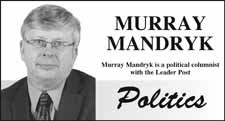Compared with their city cousins, rural folk will have lot easier time figuring out where to vote come next provincial election.
The new methodology of mapping the boundaries that excluded those under 18 years plus the addition of three extra seats - including one riding specifically designed for rural Saskatchewan - has resulted in little change to provincial rural election map. (That new rural riding is Saskatoon Stonebridge-Dakota, southeast of the city that takes in the bedroom communities in Corman Park, south to Dundurn and Whitecap First Nation and east to Elstow in the old Humboldt riding.)
Democracy watchers may question why there has been so little change in rural Saskatchewan, even though there has been a substantial population shift since the last major electoral boundaries changes in 1993. So let us a look a little closer at what the new rural ridings look like.
In the southwest, here's how it looks: Swift Current has become strictly a city seat with no rural component. Cypress Hills has gotten slightly bigger, expanding east past Simmie and Success right to edge of Swift Current. Wood River has also pushed east, taking in Coronach and Big Beaver from Weyburn-Big Muddy and Climax to the west. And Thunder Creek is gone. It is replaced by Lumsden-Morse that takes in everything north and south of No. 1 Hwy. from Swift Current to Regina (including everything surrounding Moose Jaw) and dipping as far south as Wilcox, Claybank and Avonlea.
In west-central Saskatchewan, the biggest change is the disappearance of the old Biggar seat. It is replaced by the new Biggar-Sask Valley riding, sprawling west to the Red Pheasant and Mosquito First nations and northeast of Saskatoon to Osler and Hague. Rosetown-Elrose pushes north to the edge of Biggar and loses territory to the east including Conquest and Outlook. Kindersley sees little change, other than losing Unity. Meanwhile Martensville shrinks, with only Dalmeny and Warman as its other communities.
In the northwest, there is little change except mostly for the exchange of reserves. The Battlefords picks up rural land to the east. Rosthern-Shellbrook loses the Beardy's Reserve, but picks up Jackfish Lake and the Saulteaux Reserve. Cut Knife-Turtleford picks up Unity and Wilkie, but loses the Red Pheasant and Mosquito Reserves. Lloydminster loses Beacon Hill and Big Island to Meadow Lake.
In the northwest, Saskatchewan Rivers sees little change and Carrot River Valley grows to the south to take in Little Swan River. Melfort moves a little further southwest to take in Lake Lenore and St. Brieux from Batoche that also moves a little west to take in Aberdeen and Beardy's.
Further south in the centre of the province, we see some of the biggest changes to rural seats. Arm River-Watrous becomes Arm River, that spreads from Outlook to the west, Kandahar and Kawacatoose/Day Star Reserves to east and south into the old Thunder Creek riding to take in Craik, Elbow, Marquis and Bethune. Humboldt is replaced by Humboldt-Watrous, taking in Watrous, Young and Lanigan. Last Mountain-Touchwood - the bellwether seat that has voted with the government for 70 years except in 1999 and 2003 - is unchanged.
In east central, Yorkton becomes exclusively a "city" riding while Canora-Pelly is unchanged, except adding a bit of rural Yorkton. Kelvington-Wadena now takes in Wynyard, but is otherwise unchanged. Melville-Saltcoats is also unchanged, except that it, too, has taken in some of rural Yorkton like Otthon and Tonkin.
In the southwest, Moosomin slides further west to Francis and Osage. Cannington remains intact, although it loses Frobisher to Estevan. Estevan loses Radville and Lake Alma back to Weyburn-Big Muddy that has lost Coronach to the Wood River.
But, all in all, there has not been much change to the rural election map - especially considering how much rural Saskatchewan has changed in the last 20 years.
Murray Mandryk has been covering provincial politics for over 15 years.




